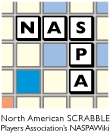Difference between revisions of "Style guide"
From NASPAWiki
You are viewing a condensed mobile version of this NASPA webpage.
Switch to full version.
(→Punctuation and Typography: more on quotes) |
(→Spelling: more on ratings) |
||
| Line 16: | Line 16: | ||
* LIGHT, not LITE | * LIGHT, not LITE | ||
* “the NSA” but no article before NASPA or NASPAWiki | * “the NSA” but no article before NASPA or NASPAWiki | ||
| − | * RATING SYSTEM, not RATINGS SYSTEM | + | * PROGRAM, not PROGRAMME |
| + | * RATING POINTS, RATING PROGRAM, RATING SYSTEM, not RATINGS POINTS, RATINGS PROGRAM, RATINGS SYSTEM | ||
== Punctuation and Typography == | == Punctuation and Typography == | ||
Revision as of 08:44, 18 March 2009
Please obey the following rules in this style guide when editing content at this web site. For issues not discussed below, consult the Wikipedia Manual of Style.
Contents
Spelling
Words should be spelled as shown in the current edition of TWL. Where variant spellings are given, use the more common and note the choice you made below. When given a choice between American and British spellings, use the American.
- COCHAIR, not CO-CHAIR
- EMAIL, not E-MAIL
- LIGHT, not LITE
- “the NSA” but no article before NASPA or NASPAWiki
- PROGRAM, not PROGRAMME
- RATING POINTS, RATING PROGRAM, RATING SYSTEM, not RATINGS POINTS, RATINGS PROGRAM, RATINGS SYSTEM
Punctuation and Typography
- Use multiple levels of headings appropriately.
- Use boldface (entered by surrounding the text by
''') only to emphasize the first appearance of the article title in the first paragraph of an article. Where possible, write the first paragraph so that it does include the article title. - Use italics (entered by surrounding the text by
'') for general emphasis, foreign/nonstandard words and the titles of books and other publications. - However, do not emphasize links. For example, use Long List and Long List, not Long List.
- Single quotes: use
‘and’(like ‘this’), not the plain'symbol. - Double quotes: use
“and”(like “this”), not the plain"symbol. - Use double quotes for the first level of quotation, single quotes for the second (nested) level. If punctuation marks need to be placed at the end of a quotation, place them inside or outside but not both. Periods and commas go inside; colons and semicolons go outside; exclamation marks and question marks go inside if they are part of the quotation and otherwise outside.
- Use quotes to enclose text whose exact appearance is important; in this case preserve both internal and external punctuation, notwithstanding the above. For example, “Click on the button labelled ‘Click me!’.” If the quoted text is to be typed by the reader, enclose it within “<code>” inside the quotes. Where possible, avoid having URLs appear in text by placing them in external links; when an URL must appear in text, enclose it in “<code>” with no quotes.
- Use
’and not'for an apostrophe. In typesetting, the apostrophe is identical to the right single quote, and there is no distinct HTML entity for the apostrophe. - Use
–(–) and not - for numerical and date ranges or elsewhere where endashes are called for. - Use
—(—) and not -- where emdashes are called for. - Use
−(−) and not - to denote subtraction. - Use
×(×) and not x to denote multiplication. - Notwithstanding the above, do not use HTML entity names (such as ’) in article titles, as some browsers do not render them correctly as browser window titles. So, for example, use a typewriter apostrophe
'in World English-language Scrabble Players' Association. - Do not use serial commas.
Dates, Times, Numbers...
- Where possible, write the name of the month in full, the day (with no ordinal suffix) and the year (four digits): “November 11, 2003”. Omit the day if it is not applicable: “August 2006”. If there isn’t room to write out a date, use an appropriate ISO 8601 format: 1899-04-13. Do not use mm/dd/yyyy or dd/mm/yyyy notation, as these are not understood in the same way throughout North America.
- Use the 12-hour clock, not the 24-hour clock. Correctly punctuate and capitalize “A.M.”, “P.M.”, “noon” and “midnight”.
- In text, write out single-digit numbers (“one”, ..., “nine”) and use numerals for larger numbers (“10”, “11”,...) or when small and large numbers are discussed in a related context.
- Use “½” for the fraction one-half.
Linking and Article Titles
- Link (only) the first occurrence of each phrase in a section to the appropriate internal wiki page.
- Where possible, avoid direct external links in unrelated pages by providing an intermediate internal page explaining or summarizing the external page. For example, link NSA rather than NSA.
- Contact information for committee members should be placed only in their individual pages, so that if it changes, only one page needs to be edited.
- Create redirect pages rather than using alternate labels for inflections or base forms of internal page names (e.g., the “committee” page redirects to “commitees” to save inexperienced editors having to write [[committees|committee]].
- Article titles should be unabbreviated nouns or noun phrases. Create redirect pages from acronyms to fully spelled out names.
Logos
The NASPA logo is available in the following formats:
- Wiki (135×112 pixel GIF)
-

- 200×100 pixel GIF as used in the NASPA home page
-

- high-resolution PDF
- File:Logo.pdf
Trademark
- Always write SCRABBLE, never Scrabble.
- Always use SCRABBLE as an adjective, not as a noun.
- Add the ® symbol to the first or more prominent use of the trademark on each page; do not add it to subsequent uses.